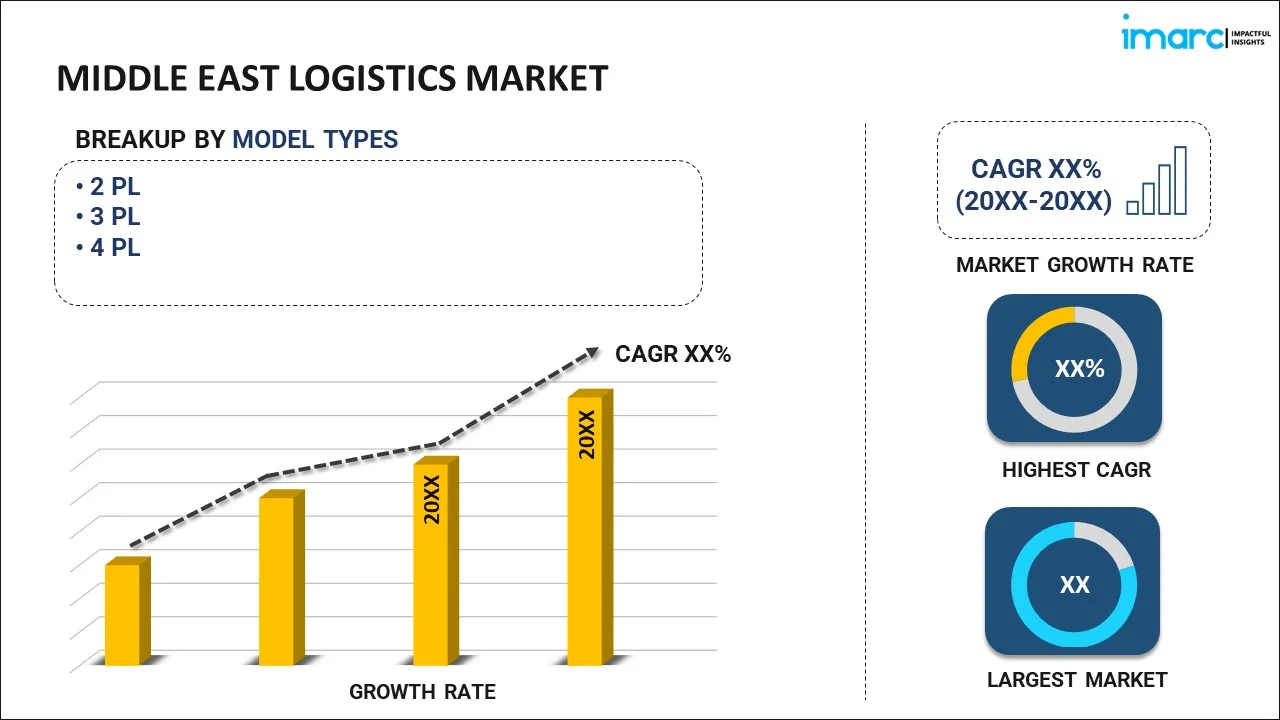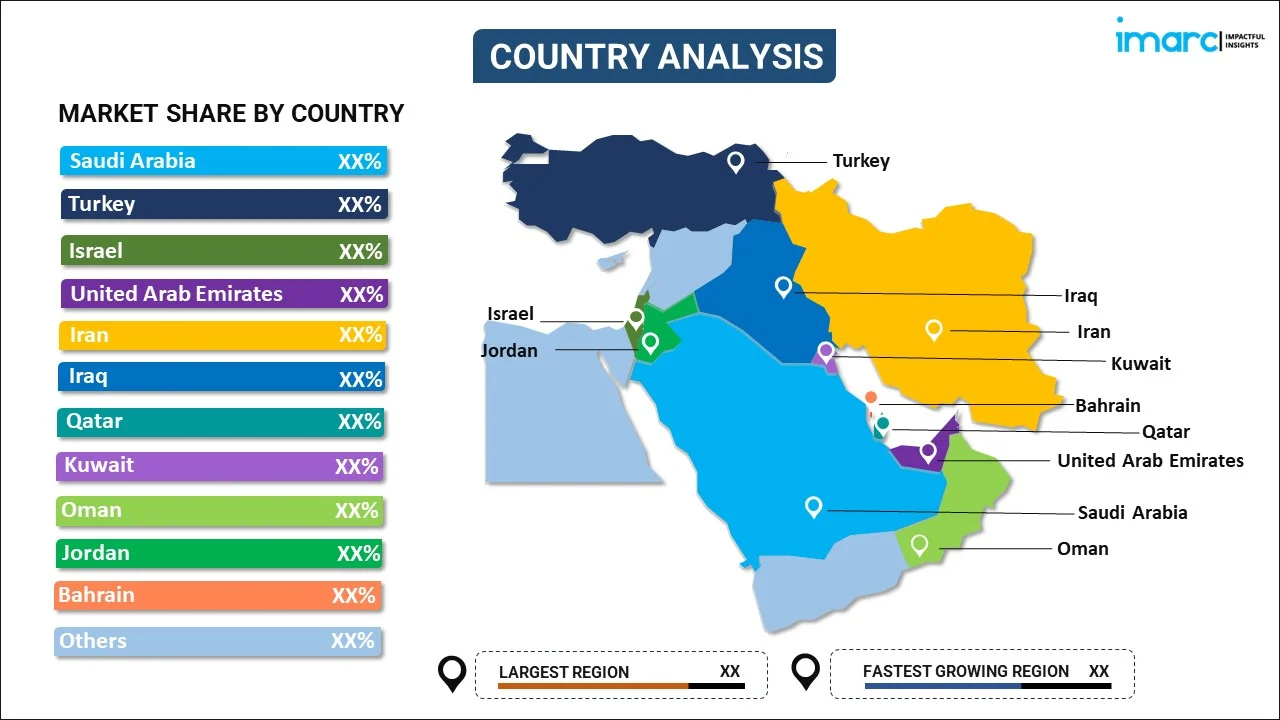
Middle East Logistics Market Report by Model Type (2 PL, 3 PL, 4 PL), Transportation Mode (Roadways, Seaways, Railways, Airways), End Use (Manufacturing, Consumer Goods, Retail, Food and Beverages, IT Hardware, Healthcare, Chemicals, Construction, Automotive, Telecom, Oil and Gas, and Others), and Country 2024-2032
Market Overview:
The Middle East logistics market size is projected to exhibit a growth rate (CAGR) of 5.80% during 2024-2032. The strategic geographic location of the region, rising diversification of economies to reduce reliance on oil, substantial government investments in infrastructure development, and rapid expansion of e-commerce represent some of the key factors driving the market.
|
Report Attribute
|
Key Statistics
|
|---|---|
|
Base Year
|
2023 |
|
Forecast Years
|
2024-2032
|
|
Historical Years
|
2018-2023
|
| Market Growth Rate (2024-2032) | 5.80% |
Logistics is a crucial component in the smooth functioning of businesses and supply chains, playing an essential role in the efficient transportation and storage of goods. At its core, logistics involves the management of the movement of goods from their point of origin to their final destination. This process encompasses a wide range of activities, including transportation, warehousing, inventory management, order fulfillment, and distribution. Effective logistics management ensures that goods are delivered on time, in the right condition, and in the most cost-efficient manner. This involves coordinating various transportation modes such as road, rail, air, and sea to optimize delivery routes and reduce transit times. Warehousing, another key aspect of logistics, comprises the safe and organized storage of products, facilitating easy access and efficient dispatch when required. In today’s globalized economy, logistics has become increasingly complex and vital. It supports the global movement of goods and significantly impacts customer satisfaction and business efficiency. As a result, logistics serves as the backbone of supply chain management, ensuring that goods are transported and stored effectively to meet the demands of businesses and consumers in a timely and cost-effective manner.
Middle East Logistics Market Trends:
The Middle East logistics market is currently witnessing significant growth, driven by a combination of factors that are reshaping the region’s logistical landscape. One of the primary drivers is the region’s strategic location, which positions the Middle East as a bridge between the East and the West, making it a pivotal hub for international trade. Major countries like the United Arab Emirates and Saudi Arabia have leveraged their geographic advantage to become central nodes in global shipping and air transport networks. Additionally, in an effort to reduce reliance on oil, various Middle Eastern countries are diversifying their economies. This shift involves significant investment in non-oil sectors like manufacturing, retail, and e-commerce, all of which demand robust logistics support, further propelling market growth. Moreover, governments in the region are heavily investing in infrastructure development. Projects like Saudi Arabia’s Vision 2030 and the UAE’s Vision 2021 include substantial allocations for the expansion of ports, airports, and road networks, directly benefiting the logistics sector. Along with this, the integration of advanced technologies such as artificial intelligence (AI), blockchain, and the Internet of Things (IoT) in logistics operations is enhancing efficiency and transparency. These innovative technologies are streamlining processes like inventory management, supply chain monitoring, and last-mile delivery, thus augmenting market growth. Furthermore, the rapid expansion of e-commerce in the Middle East, accelerated by the coronavirus (COVID-19) pandemic, necessitates advanced warehousing solutions and efficient delivery systems, which in turn has catalyzed the demand for logistics services. In line with this, the rising involvement of the Middle East in numerous international trade agreements is fostering a more open trade environment, subsequently impelling market growth. Besides this, with an increasing emphasis on speed and reliability, consumer expectations are pushing logistics providers to adopt more efficient and customer-centric delivery models, thereby fueling market growth.
Middle East Logistics Market Segmentation:
IMARC Group provides an analysis of the key trends in each segment of the market, along with forecasts at the regional and country levels for 2024-2032. Our report has categorized the market based on model type, transportation mode, and end use.
Model Type Insights:

- 2 PL
- 3 PL
- 4 PL
The report has provided a detailed breakup and analysis of the market based on the model type. This includes 2 PL, 3 PL, and 4 PL.
Transportation Mode Insights:
- Roadways
- Seaways
- Railways
- Airways
A detailed breakup and analysis of the market based on the transportation mode have also been provided in the report. This includes roadways, seaways, railways, and airways.
End Use Insights:
- Manufacturing
- Consumer Goods
- Retail
- Food and Beverages
- IT Hardware
- Healthcare
- Chemicals
- Construction
- Automotive
- Telecom
- Oil and Gas
- Others
The report has provided a detailed breakup and analysis of the market based on the end use. This includes manufacturing, consumer goods, retail, food and beverages, IT hardware, healthcare, chemicals, construction, automotive, telecom, oil and gas, and others.
Country Insights:

- Saudi Arabia
- Turkey
- Israel
- United Arab Emirates
- Iran
- Iraq
- Qatar
- Kuwait
- Oman
- Jordan
- Bahrain
- Others
The report has also provided a comprehensive analysis of all the major regional markets, which include Saudi Arabia, Turkey, Israel, United Arab Emirates, Iran, Iraq, Qatar, Kuwait, Oman, Jordan, Bahrain, and Others.
Competitive Landscape:
The market research report has also provided a comprehensive analysis of the competitive landscape in the market. Competitive analysis such as market structure, key player positioning, top winning strategies, competitive dashboard, and company evaluation quadrant has been covered in the report. Also, detailed profiles of all major companies have been provided.
Middle East Logistics Market Report Coverage:
| Report Features | Details |
|---|---|
| Base Year of the Analysis | 2023 |
| Historical Period | 2018-2023 |
| Forecast Period | 2024-2032 |
| Units | US$ Million |
| Scope of the Report | Exploration of Historical and Forecast Trends, Industry Catalysts and Challenges, Segment-Wise Historical and Predictive Market Assessment:
|
| Model Types Covered | 2 PL, 3 PL, 4 PL |
| Transportation Modes Covered | Roadways, Seaways, Railways, Airways |
| End Uses Covered | Manufacturing, Consumer Goods, Retail, Food and Beverages, IT Hardware, Healthcare, Chemicals, Construction, Automotive, Telecom, Oil and Gas, Others |
| Countries Covered | Saudi Arabia, Turkey, Israel, United Arab Emirates, Iran, Iraq, Qatar, Kuwait, Oman, Jordan, Bahrain, Others |
| Customization Scope | 10% Free Customization |
| Report Price and Purchase Option | Single User License: US$ 3699 Five User License: US$ 4699 Corporate License: US$ 5699 |
| Post-Sale Analyst Support | 10-12 Weeks |
| Delivery Format | PDF and Excel through Email (We can also provide the editable version of the report in PPT/Word format on special request) |
Key Questions Answered in This Report:
- How has the Middle East logistics market performed so far and how will it perform in the coming years?
- What has been the impact of COVID-19 on the Middle East logistics market?
- What is the breakup of the Middle East logistics market on the basis of model type?
- What is the breakup of the Middle East logistics market on the basis of transportation mode?
- What is the breakup of the Middle East logistics market on the basis of end use?
- What are the various stages in the value chain of the Middle East logistics market?
- What are the key driving factors and challenges in the Middle East logistics?
- What is the structure of the Middle East logistics market and who are the key players?
- What is the degree of competition in the Middle East logistics market?
Key Benefits for Stakeholders:
- IMARC’s industry report offers a comprehensive quantitative analysis of various market segments, historical and current market trends, market forecasts, and dynamics of the Middle East logistics market from 2018-2032.
- The research report provides the latest information on the market drivers, challenges, and opportunities in the Middle East logistics market.
- Porter's five forces analysis assist stakeholders in assessing the impact of new entrants, competitive rivalry, supplier power, buyer power, and the threat of substitution. It helps stakeholders to analyze the level of competition within the Middle East logistics industry and its attractiveness.
- Competitive landscape allows stakeholders to understand their competitive environment and provides an insight into the current positions of key players in the market.
Need more help?
- Speak to our experienced analysts for insights on the current market scenarios.
- Include additional segments and countries to customize the report as per your requirement.
- Gain an unparalleled competitive advantage in your domain by understanding how to utilize the report and positively impacting your operations and revenue.
- For further assistance, please connect with our analysts.
 Inquire Before Buying
Inquire Before Buying
 Speak to an Analyst
Speak to an Analyst
 Request Brochure
Request Brochure
 Request Customization
Request Customization




.webp)




.webp)












